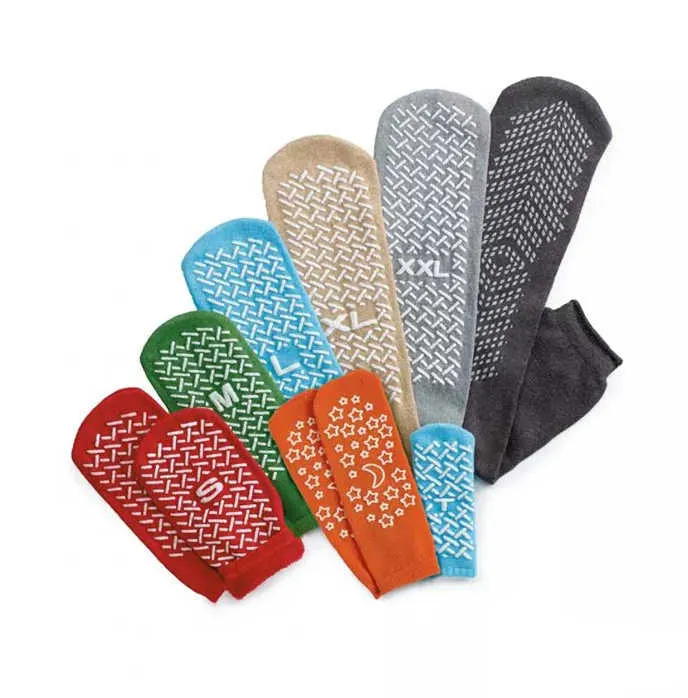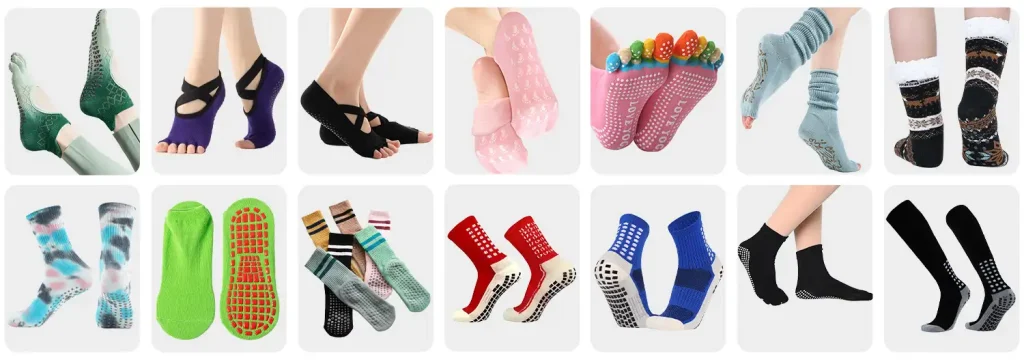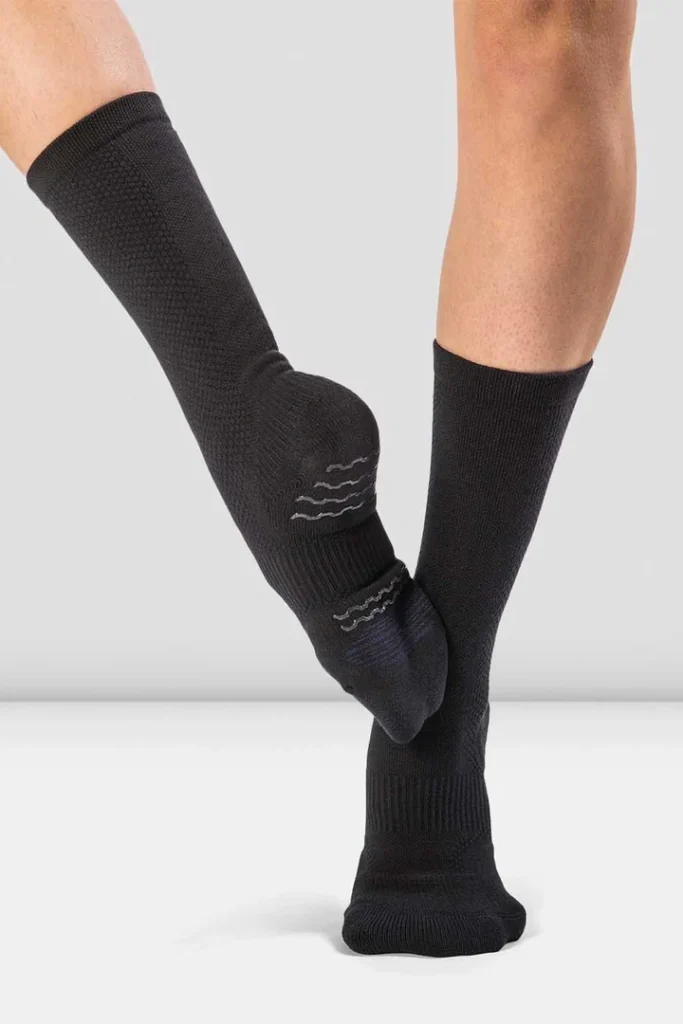Introduction
Hospital grip socks are specialized hosiery designed for in-patient and post-operative use. They combine slip-resistant soles with comfortable fabric to reduce fall risk. Unlike regular socks, they feature rubberized patterns on the bottom that improve traction on smooth hospital floors.

Patients of all ages can gain from grip socks. Older adults recovering from surgery rely on them for safe ambulation. Physical therapy clients use them during balance exercises. Even day-case patients wear them to prevent slips when walking to radiology or the restroom.
This blog dives into design elements, material choices, sizing tips, and procurement strategies. You’ll learn how to select, source, and implement grip socks in healthcare settings. By the end, you’ll be equipped to recommend fit-for-purpose products to hospitals, clinics, or care homes.
Importance of Hospital Grip Socks
Fall Prevention and Patient Safety
Slips and falls are a leading cause of in-hospital injuries. Grip socks add an extra layer of protection by boosting friction between foot and floor. Studies show non-slip footwear can cut fall rates by up to 50%, making grip socks a critical safety intervention.
Infection Control Benefits
Hospital launderable grip socks reduce cross-contamination risks. Many styles are machine-washable at high temperatures to kill pathogens. Some incorporate antimicrobial treatments that inhibit bacterial growth on fabric surfaces.
Enhancing Patient Comfort
Soft, stretchable fabrics conform to swollen ankles and surgical dressings. Breathable blends wick moisture, keeping feet dry. Padded soles and seamless toes prevent pressure points and blisters—essential for patients with delicate or sensitive skin.
Streamlining Staff Workflow
Grip socks are easier and quicker to don than conventional non-slip slippers. This simplicity saves nursing time during admissions and transfers. Standardized sock stock also reduces the need for varied shoe sizes and simplifies inventory management.
| Benefit Category | Key Advantages |
|---|---|
| Fall Prevention & Safety | Improves traction, cuts fall rates by up to 50%, supports mobility recovery |
| Infection Control | High-temp washable, antimicrobial options reduce cross-contamination risks |
| Patient Comfort | Moisture-wicking, padded soles, seamless design ease pressure and irritation |
| Staff Efficiency | Easy to apply, minimizes fitting issues, simplifies inventory and sizing |
Key Features and Materials
Non-Slip Sole Patterns
Effective grip socks use silicone or rubber dots, stripes, or herringbone patterns on the sole. The arrangement and density of these patterns determine traction. Higher-density grips perform better on wet floors; larger dots offer more surface contact.
Fabric Blends for Durability
Polyester-nylon blends dominate because they resist abrasion and retain shape after repeated washes. Adding a small percentage of spandex ensures stretch and snug fit. For budget-sensitive settings, cotton-polyester blends balance cost and performance.
Antimicrobial Treatments
Silver-ion or copper-infused yarns can be integrated to reduce odors and bacterial load. These treatments remain active over multiple laundry cycles, extending sock life and improving hygiene.
Cushioning and Breathability
Some grip socks include padded heel and toe zones for shock absorption. Mesh panels or perforated knits allow airflow, reducing moisture buildup. These design choices improve patient comfort during long stays.
Sizing and Fit Considerations
Standard Sizing vs. Custom Options
Standard grip socks come in S–XL ranges, covering most foot sizes. Custom manufacturers can offer half-sizes or extra-wide options for patients with edema or casted limbs. Customization ensures secure fit without cutting off circulation.
Measuring for Accuracy
Measure foot length from heel to longest toe and record calf circumference at the widest point. Take measurements when feet are at their largest—typically late afternoon—to accommodate any daily swelling.
Ensuring Compliance and Ease of Use
Easy-on features like tab loops or stretch-panel insteps help patients dress independently. A proper fit prevents the sock from bunching underfoot or slipping off, which both compromise traction and safety.
Implementation and Staff Training
Integrating Grip Socks into Patient Protocols
Successful roll-out begins with updating admission checklists. Include grip socks as part of the “barefoot patient” protocol alongside identification wristbands and vital-sign checks. Clearly mark storage carts and bedside bins so nursing staff can quickly locate the correct size. Consistent placement reduces delays during patient transfers from bed to chair or physical therapy, ensuring safety is maintained without fuss.
Educating Nursing and Therapy Teams
Host short in-service sessions demonstrating proper donning and removal techniques. Highlight features like tab loops, stretch panels, and non-slip patterns. Encourage staff to watch for improper fit—wrinkles under the arch or loose heels—that can undermine traction. Provide quick-reference guides or laminated cards in nurse stations showing size charts, fit tips, and troubleshooting steps to keep everyone aligned.
Patient Orientation and Buy-In
Introduce grip socks to patients during admission or pre-op briefings. Explain how the rubberized sole pattern reduces fall risk and enhances confidence when walking on slippery surfaces. For pediatric wards or long-stay units, use simple posters or bedside brochures with visual instructions. When patients understand why and how to wear their socks correctly, compliance increases and real-world benefits become evident.
Monitoring and Feedback Loops
Track fall-prevention metrics before and after grip-sock implementation to quantify impact. Encourage frontline staff to report fit issues or patient complaints via quick digital forms or whiteboard notes. Hold brief weekly huddles to address concerns—if one size runs out quickly, adjust stocking levels; if patients slip despite wearing the correct size, review donning technique. Iterative feedback ensures the program stays effective and responsive.
Procurement and Supply Chain Management
Forecasting Demand by Unit
Begin by analyzing historical fall data, patient volume, and average length of stay to estimate daily sock usage. Surgical wards often have higher turnover, while rehab units may need longer-wear items. Factor in wash cycles—if each pair is laundered daily, you’ll need roughly 1.5 times the daily census to maintain supply through washing and turnaround.
Vendor Selection and Qualification
Evaluate suppliers on product consistency, lead times, and quality‐control measures. Request detailed specifications: grip-pattern density, fabric composition, antimicrobial treatment durability, and wash-cycle guarantees. Ask for mill test reports or ISO certifications to verify manufacturing standards. Comparing multiple qualified vendors helps secure competitive pricing and backup options in case of supply disruptions.
Contracting and Bulk Ordering
Negotiate tiered pricing based on volume thresholds—e.g., discounts at 5,000, 10,000, and 20,000 pairs annually. Include clauses for price protection over a 12–24-month term to guard against market fluctuations in raw materials. Define minimum order quantities (MOQs) that balance cost efficiency with storage capacity. Clarify return policies for defective batches and restocking fees for size mismatches.
Logistics and Inventory Controls
Implement a kanban system or digital inventory management to signal reorders when stocks reach predefined levels. Use barcode or RFID tagging on sock cartons to track lot numbers, wash-cycle counts, and expiration of antimicrobial efficacy. Coordinate with linen services or central sterile processing departments for streamlined laundering and restocking, ensuring fresh socks are always available where needed.
Washing, Drying, and Reuse Protocols
Laundry Best Practices

To preserve fabric integrity and grip pattern adhesion, wash hospital grip socks in cool or warm water (30–40°C) with a mild, pH-neutral detergent. Avoid bleach, optical brighteners, and fabric softeners that degrade elastic fibers and rubberized soles. Use a gentle or low-torque cycle to minimize mechanical stress on high-wear zones.
Drying and Inspection
Tumble dry on low heat or air-dry flat to prevent shrinkage and maintain sock shape. After drying, inspect socks individually—check for worn grip dots, thinning fabric at heels or toes, and loss of elasticity at the cuff. Establish a “three-strike” rule: after three failed inspections, retire the pair to ensure patient safety.
Tracking Wash Cycles
Implement washable-item tags—barcode or durable printed labels—that survive laundering. Scan each pair at intake and out-feed to log wash counts. Most quality socks guarantee performance up to 200 cycles; replace pairs proactively once they approach their maximum rated cycles to prevent unexpected failures.
Addressing Cross-Contamination Risks
Use separate wash loads for grip socks versus linens or heavily soiled items to reduce cross-contamination. Incorporate a final high-temperature rinse (≥70°C) or chemical disinfection step if local protocols require it. Clearly label laundry carts and bins to maintain segregation, and train laundry staff on the specific handling and cycle requirements for surgical or immunocompromised-unit socks.
Patient Feedback and Outcomes
Collecting Satisfaction Data
Gathering patient feedback starts at admission and continues through discharge. Short surveys can ask about sock comfort, ease of use, and perceived slip-resistance. Incorporate questions into routine rounding so responses remain timely. Digital tablets or QR-code cards in rooms streamline data capture. Tracking satisfaction trends helps identify fit or material issues before they become systemic.
Clinical Outcome Metrics
Beyond subjective surveys, monitor objective measures such as fall rates, incidence of foot dermatitis, or complaints of sock-related discomfort. Compare these metrics before and after grip-sock adoption. A 12-month hospital study might reveal a 30% drop in patient falls and a 15% reduction in pressure-area skin breakdown. These improvements underline both safety gains and quality-of-care enhancements.
Case Studies and Testimonials
Compile brief case studies highlighting departments with notable success. For example, an orthopedic unit may report zero sock-related falls over six months, attributing the improvement to reinforced heel grips. Share testimonials from physical therapists who note easier balance training when patients wear grip socks. Real-world narratives offer compelling evidence to stakeholders evaluating broader implementation.
Continuous Improvement
Use feedback and outcomes data to refine sock selection. If patients report discomfort around the cuff, trial models with softer elastic. If slips persist on rehab floors, test socks with higher-density grip patterns. Establish quarterly review meetings with nursing leadership and suppliers to assess performance and plan adjustments. This cycle ensures grip-sock programs evolve in step with patient needs.
Regulatory and Compliance Considerations
Meeting Healthcare Standards
Grip socks used in hospitals must comply with relevant standards—often ISO 13485 for medical textiles or ASTM slip-resistance tests. Verify that chosen products have third-party certification for non-slip performance and material safety. Maintain documentation for each lot, demonstrating adherence to your facility’s quality-management protocols during audits.
Infection Control Policies
Ensure that antimicrobial treatments on socks meet local infection-control guidelines. Some hospitals require evidence of ≥99% bacterial reduction after 20 wash cycles. Request lab reports from suppliers showing efficacy of silver-ion or copper-infused finishes. Align sock-laundering procedures with your facility’s sterilization protocols to maintain compliance.
Patient Privacy and Data Security
When collecting patient feedback digitally, adhere to HIPAA or other regional privacy regulations. Store survey responses in secure systems, removing personally identifiable information before analysis. Work with your IT and compliance teams to establish data-handling workflows that protect patient confidentiality.
Environmental and Sustainability Regulations
Increasingly, healthcare procurement must consider environmental impact. Select socks manufactured in facilities with OEKO-TEX or Bluesign certifications to ensure low-chemical use and safe manufacturing. Partner with suppliers who offer take-back programs or use recycled materials, helping your institution meet sustainability reporting requirements.
| Compliance Area | Key Requirements | Recommended Actions |
|---|---|---|
| Healthcare Standards | ISO 13485, ASTM F2913 slip-resistance compliance | Request certification; document test results by batch |
| Infection Control | ≥99% bacterial reduction after 20 washes | Use silver-ion or copper-infused fabrics; verify with lab reports |
| Patient Data Privacy | HIPAA or local data protection regulations | Anonymize data; use secure systems; train staff on compliance |
| Environmental Sustainability | OEKO-TEX®, Bluesign®, or recycled materials | Source from certified suppliers; participate in textile recycling |
ROI and Cost-Benefit Analysis
Calculating Direct Cost Savings
Begin by quantifying costs associated with in-hospital falls—treatment, extended stays, potential liability. Then, compare these with the unit price of grip socks plus laundering expenses. If each fall costs an average of $12,000 and grip socks reduce falls by 50% in a 200-bed hospital, the savings quickly offset procurement costs.
Indirect Benefits and Intangibles
Beyond hard dollars, improved patient safety boosts hospital reputation, potentially increasing Medicare reimbursements tied to quality metrics. Reduced staff time handling post-fall care frees nurses for direct patient services. Higher patient satisfaction scores can enhance overall HCAHPS ratings, influencing public reporting and referrals.
Budget Forecasting and Phased Rollout
To manage upfront expenses, pilot grip-sock deployment in high-risk units—orthopedics, geriatrics, or rehab. Measure fall-rate changes and patient feedback over three months before scaling hospital-wide. Use pilot data to fine-tune order volumes and negotiate volume discounts, smoothing budget impacts while demonstrating clear ROI.
Long-Term Partnership Value
Working with a reliable factory partner like Max Hosiery ensures predictable pricing, quality consistency, and responsive support. Multi-year contracts often include price-protection clauses shielding you from raw-material cost spikes. A trusted supplier relationship reduces administrative burdens and ensures continued access to updated sock innovations as patient needs evolve.
Technology and Innovation in Grip Sock Design
Advanced Grip Materials
Recent advances have introduced specialized polymers and thermoplastic elastomers for enhanced slip resistance. These materials bond more securely to fabric, maintaining traction even after hundreds of wash cycles. By selecting grip compounds that stay flexible at low temperatures, manufacturers ensure performance on cold, slick surfaces often found in hospital corridors.
Smart Fabric Integration
Textiles embedded with phase-change materials (PCMs) regulate foot temperature by absorbing and releasing heat as needed. In hospital settings where patients may be immobile for long periods, PCM-infused fibers prevent overheating and maintain comfort. Some developers are exploring moisture-sensing yarns that change color when socks become saturated, prompting timely changes and reducing infection risk.
RFID and Inventory Tracking
Integrating RFID tags into sock cuffs streamlines inventory management in large facilities. Each pair carries a tiny chip encoded with lot number, size, and wash-cycle history. Wireless scanners at laundry inlets and distribution points automate tracking, ensuring that socks nearing their service limit are automatically flagged for replacement without manual logging.
Sustainable Manufacturing Processes
To meet growing environmental mandates, innovative processes such as closed-loop dyeing and waterless finishing are gaining traction. Factories now capture and reuse over 90% of water used in dye baths. Biodegradable grip polymers derived from plant sources are entering pilot production, promising full-cycle sustainability without compromising performance.
Market Trends and Future Outlook
Rising Demand in Aging Populations
Global demographics skew older, driving higher demand for fall-prevention products. Hospitals and long-term care facilities increasingly adopt grip socks as standard issue for geriatric units. Projections estimate a 7% annual growth in medical-grade non-slip hosiery over the next five years.
Customization and Branding Opportunities
Healthcare providers seek to differentiate patient experiences through branded apparel. Grip socks bearing hospital logos—in calming colors tied to patient wings—enhance institutional identity. At the same time, personalization for bariatric or pediatric patients (fun patterns, larger sizes) boosts compliance and satisfaction.
Regulatory Shifts and Reimbursement Models
New patient-safety reimbursement incentives link fall rates to Medicare and insurance compensation. Facilities that demonstrate measurable fall reductions through grip-sock programs can qualify for higher reimbursements. Regulatory bodies are also moving toward mandating non-slip hosiery in certain high-risk wards, cementing grip socks’ role in standard care.
H3: Sustainability as a Differentiator
Beyond safety, hospitals are under pressure to cut environmental impact. Grip socks marketed with third-party eco-certifications—OEKO-TEX®, Bluesign®—gain preference in procurement reviews. Looking ahead, full life-cycle assessments (LCA) may be required to demonstrate reduced carbon footprint from raw material to disposal.
Conclusion
Selecting the right hospital grip socks is more than a procurement choice—it’s an investment in patient safety, comfort, and operational efficiency. From advanced grip compounds to smart-tracking technologies, modern designs address fall prevention, infection control, and sustainability. By partnering with an experienced manufacturer who offers customization, reliable quality control, and forward-looking innovations, healthcare providers can implement a grip-sock program that delivers measurable outcomes and aligns with regulatory and environmental goals.

Ready to enhance patient safety and streamline your supply chain? Contact Max Hosiery today to develop bespoke hospital grip socks tailored to your facility’s needs—from advanced materials to branding and tracking features.
FAQ
What makes hospital grip socks safer than slippers?
Grip socks offer secure, uniform traction across the entire sole, reducing slip risk on smooth floors better than loose-fitting slippers.
How often should grip socks be replaced?
Replace after 150–200 wash cycles or when grip patterns show wear to maintain reliable non-slip performance.
Can grip socks help prevent hospital-acquired infections?
Yes—machine-washable antimicrobial treatments and high-temperature laundering protocols reduce pathogen transmission.
Are custom-printed grip socks more expensive?
Custom branding incurs a one-time art setup fee, but bulk orders typically achieve competitive per-unit pricing.
Do RFID-enabled socks require special laundry equipment?
No—RFID tags are laundry-safe and work with standard industrial washers; scanners at key points automate tracking.
